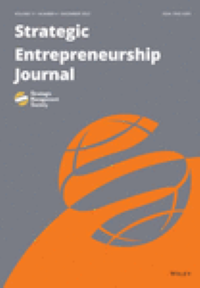传统、创业和创新:日本高级餐饮的工艺
IF 6.3
2区 管理学
Q1 BUSINESS
引用次数: 0
摘要
研究摘要本研究探讨了传统工艺如何产生新颖性,这似乎与传统工艺强调的延续相矛盾。以往的研究探讨了传统如何从过去被重新发现和复兴,而传统工艺则可能通过自身的重复行为产生内在的新颖性。本研究探讨的是日本料理怀石料理(Kaiseki),它既是传统的,同时又是创新的。通过对一位知名厨师的设计过程进行分析,我们发现这位厨师在设计新颖菜肴时,会对前人的做法做出回应,做出更好、更与众不同的菜肴,从而超越传统的局限;怀石料理的传统正是通过这种做法得以重新演绎的。吉尔斯-德勒兹(Gills Deleuze)的过程哲学被用来解释我们的 "作为能力的传统 "和 "作为对象的传统 "的概念。本研究解释了手工艺如何既传统又创新。通常,创新被解释为与新技术的重新组合,以及恢复和重新诠释以重振植根于过去的身份,而本研究则揭示了手工艺实践中的内在新颖性。这种新颖性在被称为 "怀石料理 "的传统日本料理中显而易见,怀石料理是传统的,但也是创新的,因为顾客追求的是新颖精致的体验,就像《米其林指南》中的任何一家星级餐厅一样。通过对厨师做法的分析,我们提出了 "传统即能力 "的新概念。传统作为能力的创造力对于创造新机遇和新价值非常重要。本文章由计算机程序翻译,如有差异,请以英文原文为准。
Tradition, entrepreneurship, and innovation: The craft of Japanese fine dining
Research SummaryThis study explores how traditional craft produces novelty, which appears to be at odds with its emphasis on continuation. While prior research has explored how tradition is rediscovered and revived from the past, traditional craft can produce intrinsic novelty potentially through its own repetitive acts. This study examines a Japanese cuisine Kaiseki , which is traditional but simultaneously innovative. The analysis of a well‐known chef's design processes reveals that the chef designs novel dishes by responding to what has been done before, making something better and differently and thereby going beyond the limit of the tradition; Kaiseki tradition is re‐enacted through such practices. A process philosophy of Gills Deleuze is engaged to explain our concept of “tradition as capacity” as well as “tradition as object.”Managerial SummaryTradition is now seen as important source of value. This study explains how craft can be both traditional and innovative. Typically, innovation has been explained by recombination with new technologies and restoration and reinterpretation to reinvigorate identity rooted in the past, this study sheds light on the intrinsic novelty within the practices of craft. This novelty is evident in traditional Japanese cuisine, called Kaiseki , which is traditional but also innovative because customers seek novel exquisite experience as they do in any Michelin Guide starred restaurants. Through the analysis of a chef's practices, we propose a new conceptualization of tradition as capacity. The creative force of this tradition as capacity is important for creating new opportunities and novel values.
求助全文
通过发布文献求助,成功后即可免费获取论文全文。
去求助
来源期刊

Strategic Entrepreneurship Journal
Multiple-
CiteScore
11.10
自引率
1.60%
发文量
31
期刊介绍:
The Strategic Entrepreneurship Journal is a research journal that publishes original work recommended by a developmental, double-blind review process conducted by peer scholars. Strategic entrepreneurship involves innovation and subsequent changes which add value to society and which change societal life in ways which have significant, sustainable, and durable consequences. The SEJ is international in scope and acknowledges theory- and evidence-based research conducted and/or applied in all regions of the world. It is devoted to content and quality standards based on scientific method, relevant theory, tested or testable propositions, and appropriate data and evidence, all replicable by others, and all representing original contributions. The SEJ values contributions which lead to improved practice of managing organizations as they deal with the entrepreneurial process involving imagination, insight, invention, and innovation and the inevitable changes and transformations that result and benefit society.
 求助内容:
求助内容: 应助结果提醒方式:
应助结果提醒方式:


